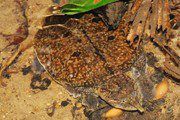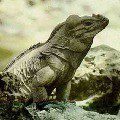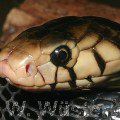
Dogania
DOGANIA (Dogania subplana) has a large head. Its general coloration is greyish-brown with four dark spots on its back. It lives in reservoirs with lush vegetation and a muddy bottom in which it likes to dig. Usually they are kept in aquariums, well-washed sand with a depth of at least 10 cm is placed at the bottom. Carnivorous, prefers red food. Young dogs willingly feed on bloodworms and tubifex. Like all soft-bodied turtles, Dogania willingly eats small fresh freshwater fish or pieces of sea fish. Sometimes they can eat dried shrimp soaked in water.
Sources of
http://ru.wikipedia.org
http://webmvc.com
http://www.biodat.ru
http://www.megabook.ru
Content
Usually, an aquarium is required for keeping in captivity. It is desirable to pour river sand at the bottom, at least 10 cm deep. As for feeding, they easily digest beef heart, which needs to be finely chopped, earthworms. It can also be fed with fresh small freshwater fish or pieces of sea fish. Sometimes they can be tempted by dried shrimp, only they will need to be pre-soaked in water.
Reproduction
 In order for Dogans to breed, you will need a large spacious aquarium, which will have plenty of hiding places so that adults can easily determine their territorial spaces. They breed very well in captivity.
In order for Dogans to breed, you will need a large spacious aquarium, which will have plenty of hiding places so that adults can easily determine their territorial spaces. They breed very well in captivity.
When kept in captivity, the female Doganii can lay 3-4 clutches. Each contains from 3 to 7 rounded eggs (22×31 mm in size), they are covered with a hard shell. Laying takes place between January and June.
Young individuals are born after 72 days of gestation.
The incubation period in captivity should be at 28 degrees.
Food
This turtle is carnivorous. Prefers “products” of red color. Juveniles readily feed on tubifex and bloodworms.
Other names
Malayan softshell turtle
Inhabitation
This turtle is common in Thailand, Myanmar, Malaysia, Laos and Cambodia (western regions), Indonesia (Borneo, Java, Singkep, Sumatra, Natuna Besar), on the Mergui archipelago, Singapore.
Prefers ponds with a muddy bottom, in which it often burrows, and lush vegetation.
Description
 Dogania is a small turtle. The length of the carapace is usually about 25 cm. The carapace itself is oval in shape, with several longitudinal rows of small tubercles, very flat. Carapace gray-brown. Sometimes four dark spots and a middle dark longitudinal strip appear. The neck of this turtle is thick and short (unlike other soft-bodied turtles). The head is large, with a pointed proboscis at the end. Between the eyes and on the head there is a dark pattern, triangular in shape.
Dogania is a small turtle. The length of the carapace is usually about 25 cm. The carapace itself is oval in shape, with several longitudinal rows of small tubercles, very flat. Carapace gray-brown. Sometimes four dark spots and a middle dark longitudinal strip appear. The neck of this turtle is thick and short (unlike other soft-bodied turtles). The head is large, with a pointed proboscis at the end. Between the eyes and on the head there is a dark pattern, triangular in shape.
Plastron is light. It bears four calloused, rather poorly developed thickenings. Most often, only xiphiplastral thickenings can be distinguished. Legs with sharp claws, powerful, with well-developed membranes.
Dogania likes to burrow into the sand and does it very quickly. Having carefully dug in, she throws sand on her back and on other parts of the body, and after a few minutes only one proboscis can be seen on the surface of the sand. Its flexible, flattened shell allows it to hide under large rocks and boulders, of which there are a great many at the bottom.
This is not a very peaceful turtle; cases of bites and injuries of their own kind are not uncommon. Accordingly, they must be kept separately.





